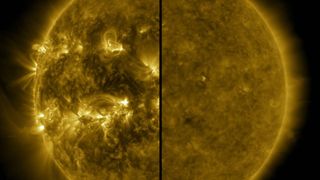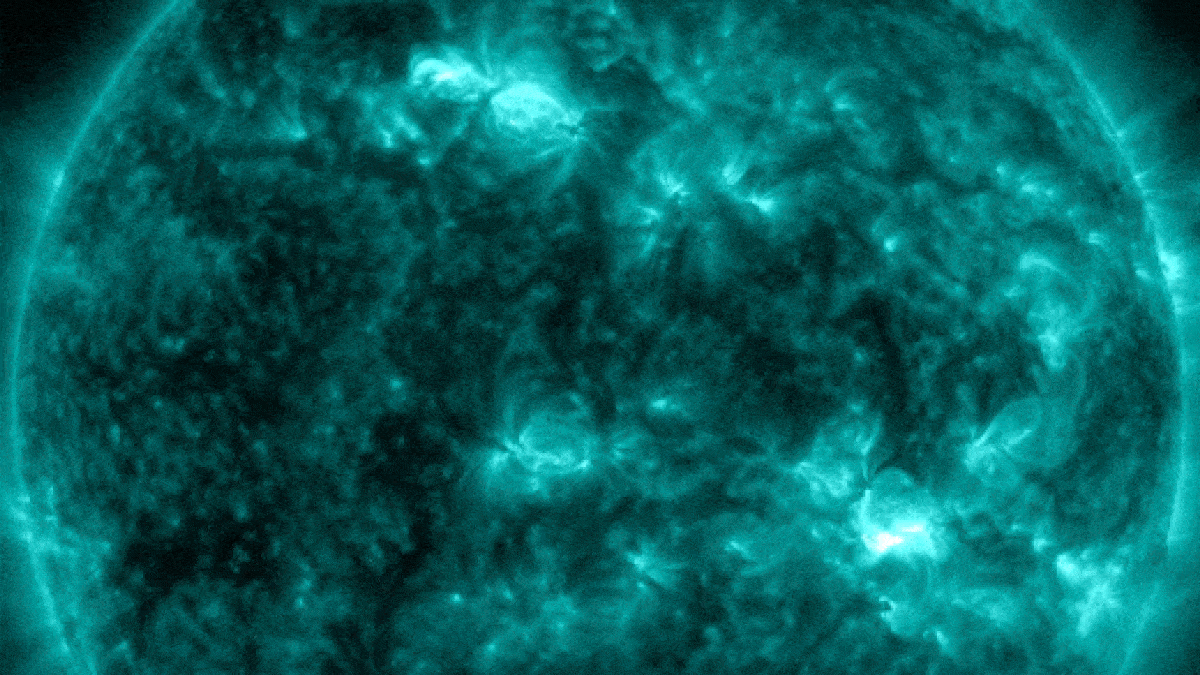Solar maximum may already be upon us, expert warns — but we won't know for sure until the sun's explosive peak is over
A solar physicist who accurately predicted that the sun's explosive peak would arrive sooner — and be more powerful — than originally forecast tells Live Science that it may have already begun. However, we won't know for sure until long after it has finished.

Although it initially wasn't predicted to occur until next year, the sun may have already entered the most active and dangerous phase of its roughly 11-year solar cycle, known as solar maximum, a leading expert told Live Science. But we won't know for sure until long after the sun starts to calm down again over the next few years.
During solar maximum, the number of dark-colored sunspots peppering the sun's surface increases significantly. As a result, they spit out more frequent and more powerful solar storms, some of which can smash into Earth, causing radio blackouts and stunning auroras.
This activity spike is caused by the sun's magnetic-field lines gradually becoming more tangled. But at some point during solar maximum, these magnetic-field lines snap, resulting in the total reversal of the star's magnetic poles — where the magnetic south and north poles swap places. After this, the sun begins to calm down and eventually reaches solar minimum, when sunspots and solar storms disappear almost completely before the next cycle begins.
In 2019, the Space Weather Prediction Center (SWPC), which is run by the National Oceanic and Atmospheric Administration (NOAA), released the forecast for the current solar cycle (Solar Cycle 25), which began that year. The forecast, which was made by a panel of scientists from NOAA, NASA and the International Space Environment Services, predicted that the upcoming solar maximum would be comparable in size to the relatively weak maximum of the previous cycle (Solar Cycle 24) and likely wouldn't arrive until 2025.
However, other scientists soon noticed that the sun's fiery behavior deviated from that forecast. Sunspots cropped up much more frequently than expected and spewed powerful solar storms far more often than predicted. And last June, several researchers told Live Science that solar maximum would likely begin earlier — and be more active — than the initial forecasts suggested, potentially arriving in early 2024.
Related: 15 signs the sun is gearing up for its explosive peak — the solar maximum

One of those researchers was Scott McIntosh, a solar physicist and deputy director of the National Center for Atmospheric Research in Colorado. As Solar Cycle 25 began in 2019, McIntosh and his team discovered that a previously unknown type of magnetic anomaly, known as solar terminator events, had preceded most past maximums on record. After looking at the most recent solar terminator, McIntosh's team realized that the initial predictions could be wrong and later used this information to plot the alternative solar cycle timeline reported by Live Science.
Sign up for the Live Science daily newsletter now
Get the world’s most fascinating discoveries delivered straight to your inbox.
These findings were not considered by the Solar Cycle 25 prediction panel. But last October, the SWPC acknowledged that the initial forecasts were off and, for the first time ever, released updated predictions suggesting solar maximum would likely arrive between January and October of this year.

In the months since the SWPC update, solar activity has been up and down, with a sharp peak in December and an unusual lull in January, which has made it hard to gauge when solar maximum might arrive. However, a recent flurry of activity in February suggests it may have started.
"I think that we are definitely entering that phase of activity," McIntosh told Live Science in an email. However, the official beginning and end of solar maximum are hard to pinpoint in real time because you can only tell when sunspot numbers peaked after they start to drop again, McIntosh said.
The SWPC typically announces when solar maximum officially began at least seven months after sunspot numbers start to drop following the maximum, Live Science's sister site Space.com previously reported. As a result, we won't officially know when it started for several years.
But there is another way we can track solar maximum's arrival, McIntosh said: the strength of the sun's magnetic field.

In the lead-up to solar maximum, the magnetic-field strength at the sun's poles decreases and eventually reaches zero during polar reversal, McIntosh said. We can track this in real time, and over the past few months, the polar magnetic-field strength has been "hovering around zero," he added.
Related: A once-in-a-lifetime view of the sun's 'solar maximum' is coming April 8
January's solar activity lull meant it was unlikely that solar maximum had truly kicked in. As a result, McIntosh was waiting for a "surge" in activity before he was convinced we were entering the sun's explosive peak. And that surge may have happened in February.





Last month, X-class solar flares — the sun's most powerful type of explosion — made a major comeback, with one gargantuan sunspot spitting out three X-class flares in less than 24 hours, including the most powerful flare in more than six years. Photographers also captured stunning photos of a massive plume of plasma erupting from near the sun's south pole and ghostly plasma loops after another major flare, both of which are more common around solar maximum.

The sun is quickly approaching a major peak in solar activity. Experts warn the solar maximum could peak years before initial predictions suggested. Why is this happening now, and what does it mean for life on Earth?
Read more
So if solar maximum has (unofficially) arrived, what can we expect? It will likely last around a year, or maybe less, McIntosh said. Although sunspots will start to drop off, the number of powerful solar flares will actually peak after solar maximum, meaning we will have several years of increased solar storms, he added.
If any of the largest storms slam into Earth, they could impact ground-based infrastructure, trigger widespread auroras at lower latitudes and cause satellites to tumble back to Earth.
Past research, has suggested that geomagnetic disturbances caused by solar storms can also disrupt the navigation ability of migrating animals, such as whales. As a result, we could see an increase in whale stranding over the next few years.

There is also a slim chance of a once-in-a-lifetime solar storm, such as the 1859 Carrington Event, which could cause trillions of dollars' worth of damage to power infrastructure and satellites if it hit us directly.
However, despite the current solar maximum being more powerful than originally forecast, it is still slightly weaker than other historic maximums, McIntosh said, suggesting that we may escape the worst effects this time around.

Harry is a U.K.-based senior staff writer at Live Science. He studied marine biology at the University of Exeter before training to become a journalist. He covers a wide range of topics including space exploration, planetary science, space weather, climate change, animal behavior, evolution and paleontology. His feature on the upcoming solar maximum was shortlisted in the "top scoop" category at the National Council for the Training of Journalists (NCTJ) Awards for Excellence in 2023.
Most Popular



